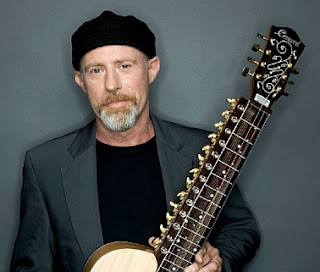Harry Manx
The Introduction:
The rain stops
just as I get out of the car, brilliant sunshine breaking through, illuminating
the scene, rolling hills all dripping wet. Harry Manx himself opens the door, barefoot, clad mostly in
black, a beanie on his head and a smile on his face, we shake hands. He introduces me to the three people
hanging out in the kitchen, one of whom is local artist Yeshe, who I’ve met
before and who is touring with Manx later this month, they’ve toured together a
lot in Canada before as well. We
all shake hands.
Someone offers to
put on the kettle and soon there are cups lined up on the bench, various
teabags (green, ordinary, camomile, mint) being added, sugar and hot
water. Harry and I chat as we
stir, did I find the place OK?
Where did that storm just spring from? How nice is it in the sun? I say goodbye to Yeshe, and Harry leads me out the back to
what seems to be one of many small decks – this house is gargantuan – and we
sit, get comfortable, I find my notebook and Dictaphone, leaning back on the
couch I’m sitting on.
Harry is on some
sort of rocking chair, he sits right on the front edge of it, his cup cradled
in his hands. The birds have come
out after the rain, they fill the trees with their posturing, the air with
their call. “I actually know
someone who moved away from here because of the birds, they were too loud,”
smiles Harry as we watch them all. I laugh and say that’s ridiculous. It’s warm in the sun, everything is glistening, I pick up my
pen and we begin to talk.
***
The Indian Influence:
“I’ve always had
a fascination with India, my father used to go there a lot when I was a kid, he
was a sailor,” Manx says thoughtfully, his voice almost drowned out by
birdsong. “I first went there in
’79, I hitchhiked all through Europe and went through Turkey, got caught in a
revolution in Iran, into Pakistan, and I didn’t actually know I was going there on a musical journey at first. I was attracted to the whole culture,
the spiritual aspect, it was one of those places where I felt at home right
away.
“So I knocked
around that first year, played a little sitar, and I decided to go back in ’86
and I took an apartment there and kept that apartment until ’98, so I was
around there for, like, 12 years.
I studied, starting with the sitar, but I had a feeling that wasn’t
quite it. I didn’t want to be playing sitar in an Indian restaurant
somewhere, I just didn’t see myself doing that.
“But I loved the
music and I just studied it for my own joy, that’s what it was for a long
time. You don’t really get into
the Indian sounds until you’ve been there for a while, and then you see how
they fit into the whole greater picture of India, you know? This music, it really is the soundtrack for the life there, because the
music has great depth, like the African stuff, you can hear the history of
that. And they found that certain
arrangements of notes can create a certain mood,
have a certain vibe… I was pulled in
to those sounds.”
“And in a lot of
ways, those ragas sound bluesy, so
deep, especially the late night ragas,” he says with a fond smile, no doubt
taking himself back to some of those late nights, around a fire perhaps, lost
deep within an ancient groove, the music becoming a part of the situation
itself. “They’re so deep and dark and you wanna move into it, you know? I kept thinking, when I was studying,
‘Man, this is just really heavy
blues’, that’s what this is, Indian style. A light went off in my head.”
...
Samuel J. Fell



No comments:
Post a Comment